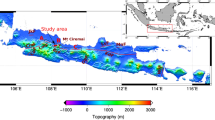Summary
The MT method is applied to the study of a buried graben in the western Canadian sedimentary basin. Tensor analysis and two dimensional numerical modeling techniques were applied as an aid to the interpretation. The results obtained indicate the presence of a buried geoelectric structure and the need of interpreting MT apparent resistivity curves in terms of the regional geology and major structural features which are not necessarily one dimensional.
Similar content being viewed by others
References
L. Cagniard,Basic theory of the magneto-telluric method of geophysical prospecting, Geophysics18 (1953), p. 605.
R. M. Clowes, E. R. Kanasewich andG. Cumming,Deep crustal seismic reflections at near vertical incidence, Geophysics33 (1968), p. 441.
J. W. Cooley andJ. W. Tukey, 1965,An algorithm for the machine calculation of complex Fourier series, Math. of Computations19 (1965), p. 297.
R. A. Fowler, J. B. Kotick andR. D. Elliot,Polarization analysis of natural and artificially induced geomagnetic micropulsations, JGR72, no. 11 p. 2871.
W. M. Gentleman andG. Sande,Fast fourier transform for fun and profit, Fall Joint Computer Conf., AF IPS Proc.29 (1966), p. 563.
G. M. Jenkins andD. G. Watts, Spectral Analysis and its applications (San Francisco, Holden Day, 1968).
T. Madden andW. Thompson,Low frequency electromagnetic oscillations of the earth-ionosphere cavity, Rev. Geophys. 3 no. 2 (1965), p. 211.
R. G. McCrossan andR. P. Glaister,Geological history of western Canada, Alberta Soc. Petrol. Geol. (Calgary, Alberta, 1964).
H. F. Morrison, E. Wombwell andS. H. Ward,Analysis of earth impedances using magnetotelluric fields, JGR73 (1968), p. 2769.
E. Parzen,Mathematical considerations in the estimation of spectra, Technometrics3 (1961), p. 167.
W. J. Peeples,Magneto-telluric profiling over a deep structure, Ph.D. Dissertation, Department of Physics, University of Alberta, Edmonton (1969).
A. T. Price,The theory of the magnetotelluric method when the source field is considered, JGR67 p. 1907.
D. Rankin,The magnetotelluric effect on a dike, Geophysics27 (1962), p. 666.
D. Rankin andR. D. Kurtz,A statistical study of micropulsation polarization, JGR 75, no. 28 p. 5444.
C. M. Swift Jr.,A magnetotelluric investigation of an electrical conductivity anomaly in the southwestern United States, Ph.D. Dissertation, Geophysics Laboratory, Massachusetts Institute of Technology, Cambridge (1967).
K. Vozoff, H. Hasegawa andR. M. Ellis,Results and limitations of magnetotelluric surveys in simple geologic situations, Geophysics28 (1963), p. 778.
J. R. Wait,Theory of magneto-telluric fields, Journ. Nat. Bur. Standards66D (1962), p. 509.
Author information
Authors and Affiliations
Rights and permissions
About this article
Cite this article
Peeples, W.J., Rankin, D. A magnetotelluric study in the western Canadian sedimentary basin. PAGEOPH 102, 134–147 (1973). https://doi.org/10.1007/BF00876600
Received:
Issue Date:
DOI: https://doi.org/10.1007/BF00876600




